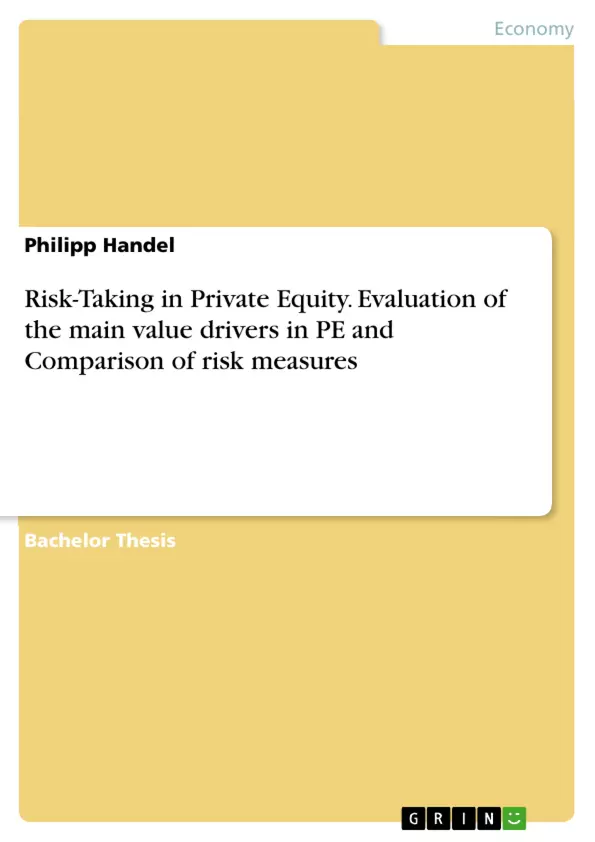
Risk-Taking in Private Equity. Evaluation of the main value drivers in PE and Comparison of risk measures
Bachelorarbeit, 2017
36 Seiten, Note: 1,3
Leseprobe
Inhaltsverzeichnis (Table of Contents)
- 1 Introduction
- 2 Cash Flow, Return and Risk Characteristics
- 2.1 Value added by General Partners
- 2.2 How General Partners impact risk-taking
- 3 Evaluating Risk on Fund Level
- 3.1 Risk factors
- 3.2 Research on historical risk frameworks
- 3.3 Relevance of traditional finance approaches
- 3.4 Measuring risk in return
- 4 Risk Perceived by Investors
- 4.1 Significance of track records in Private Equity
- 4.2 Relevance of recent advances in behavioral finance
- 4.3 Identifying proxies for perceived risk
- 5 Conclusion
Zielsetzung und Themenschwerpunkte (Objectives and Key Themes)
This thesis examines risk-taking in private equity (PE) from an investor's perspective. It aims to understand how risk is evaluated at the fund level and how investors perceive the risk associated with PE investments. The study considers the role of general partners (GPs) in influencing risk and examines the relevance of traditional finance and behavioral finance approaches to understanding risk in this context.
- Risk assessment in private equity from the investor's viewpoint
- The impact of general partners on risk-taking in PE funds
- The role of traditional and behavioral finance in understanding PE risk
- Investor perception of risk and the significance of track records
- Measurement of risk and return in the context of PE investments
Zusammenfassung der Kapitel (Chapter Summaries)
1 Introduction: This introductory chapter sets the stage by highlighting the growth of private equity (PE) as an asset class, emphasizing its substantial capital inflows and the inherent link between returns and risk. It underscores the illiquidity of PE funds and the significant risk faced by investors, particularly institutional investors like pension funds. The chapter establishes the thesis's focus on risk-taking in PE from an investor's perspective, differentiating between buy-out and venture capital segments within PE, and outlining the structure of PE funds as partnerships between general partners (GPs) and limited partners (LPs).
2 Cash Flow, Return and Risk Characteristics: This chapter delves into the characteristics of cash flow, return, and risk within PE investments. It analyzes the value added by general partners, exploring financial, operational, and governance engineering, and the fees they charge. The chapter investigates how GPs' actions directly influence the risk profile of PE investments, laying the groundwork for subsequent analyses of risk assessment and investor perception.
3 Evaluating Risk on Fund Level: This chapter focuses on evaluating risk at the fund level, exploring key risk factors such as shortfall risk, funding risk, and liquidity risk. It reviews existing research on historical risk frameworks and assesses the relevance of traditional finance approaches to PE risk measurement. The chapter also discusses methods for measuring risk in relation to return, providing a framework for understanding the quantitative aspects of PE risk.
4 Risk Perceived by Investors: This chapter examines how investors perceive risk in private equity. It explores the importance of track records in shaping investor perceptions and investigates the relevance of recent advancements in behavioral finance in understanding investor decision-making in the context of PE. The chapter introduces and applies methodologies for identifying proxies for perceived risk, providing practical tools for assessing investor sentiment towards PE investments.
Schlüsselwörter (Keywords)
Private Equity, Risk-Taking, General Partners, Limited Partners, Risk Measurement, Return, Investor Perception, Behavioral Finance, Illiquidity, Fund Level Risk, Track Record, Leveraged Buy-outs, Venture Capital.
Frequently Asked Questions: A Comprehensive Language Preview of Risk-Taking in Private Equity
What is the main topic of this document?
This document is a comprehensive preview of a thesis examining risk-taking in private equity (PE) from an investor's perspective. It analyzes how risk is evaluated at the fund level and how investors perceive the risk associated with PE investments. The role of general partners (GPs) in influencing risk and the relevance of traditional and behavioral finance approaches are also explored.
What are the key themes explored in the thesis?
The key themes include risk assessment in private equity from the investor's viewpoint; the impact of general partners on risk-taking in PE funds; the role of traditional and behavioral finance in understanding PE risk; investor perception of risk and the significance of track records; and the measurement of risk and return in the context of PE investments.
What topics are covered in each chapter?
Chapter 1 (Introduction): Introduces the growth of private equity, its inherent risks, and the focus on investor perspective. It defines the structure of PE funds (GPs and LPs) and distinguishes between buy-out and venture capital segments.
Chapter 2 (Cash Flow, Return and Risk Characteristics): Analyzes the characteristics of cash flow, return, and risk in PE, focusing on the value added by general partners and their influence on the risk profile of investments.
Chapter 3 (Evaluating Risk on Fund Level): Explores risk evaluation at the fund level, including key risk factors (shortfall risk, funding risk, liquidity risk), reviews existing research on historical risk frameworks, and assesses the relevance of traditional finance approaches to PE risk measurement.
Chapter 4 (Risk Perceived by Investors): Examines investor perception of risk, the importance of track records, the relevance of behavioral finance, and methodologies for identifying proxies for perceived risk.
Chapter 5 (Conclusion): [Content not detailed in preview]
What is the role of General Partners (GPs) according to this document?
The document highlights the significant role of General Partners (GPs) in influencing risk-taking within Private Equity funds. Their actions, including financial, operational, and governance strategies, directly impact the risk profile of PE investments. The fees they charge are also analyzed in relation to value added.
How does this document address risk measurement in Private Equity?
The document explores both traditional finance approaches and the relevance of behavioral finance in understanding and measuring risk in private equity. It examines various methods for measuring risk in relation to return and considers risk factors such as shortfall risk, funding risk, and liquidity risk at the fund level. The importance of investor perception and the use of proxies for perceived risk are also discussed.
What is the significance of investor perception and track records in this context?
Investor perception of risk is a central theme. The document emphasizes the significant role of track records in shaping investor perceptions and decisions regarding private equity investments. It also explores how recent advancements in behavioral finance can help understand investor decision-making in this context.
What are the key words associated with this thesis?
Key words include Private Equity, Risk-Taking, General Partners, Limited Partners, Risk Measurement, Return, Investor Perception, Behavioral Finance, Illiquidity, Fund Level Risk, Track Record, Leveraged Buy-outs, and Venture Capital.
Details
- Titel
- Risk-Taking in Private Equity. Evaluation of the main value drivers in PE and Comparison of risk measures
- Hochschule
- Technische Universität München (TUM School of Management - Chairs of Entrepreneurial Finance)
- Note
- 1,3
- Autor
- Philipp Handel (Autor:in)
- Erscheinungsjahr
- 2017
- Seiten
- 36
- Katalognummer
- V383578
- ISBN (eBook)
- 9783668610590
- ISBN (Buch)
- 9783668610606
- Dateigröße
- 705 KB
- Sprache
- Englisch
- Schlagworte
- private equity venture capital buy-out buyout lbo risk finance asset management portfolio
- Produktsicherheit
- GRIN Publishing GmbH
- Preis (Ebook)
- US$ 17,99
- Preis (Book)
- US$ 20,99
- Arbeit zitieren
- Philipp Handel (Autor:in), 2017, Risk-Taking in Private Equity. Evaluation of the main value drivers in PE and Comparison of risk measures, München, Page::Imprint:: GRINVerlagOHG, https://www.diplomarbeiten24.de/document/383578
- Autor werden
- Ihre Optionen
- Vertriebskanäle
- Premium Services
- Autorenprofil
- Textarten und Formate
- Services für Verlage, Hochschulen, Unternehmen

- © GRIN Publishing GmbH.
- Alle Inhalte urheberrechtlich geschützt. Kopieren und verbreiten untersagt.
- info@grin.com
- AGB
- Open Publishing
Der GRIN Verlag hat sich seit 1998 auf die Veröffentlichung akademischer eBooks und Bücher spezialisiert. Der GRIN Verlag steht damit als erstes Unternehmen für User Generated Quality Content. Die Verlagsseiten GRIN.com, Hausarbeiten.de und Diplomarbeiten24 bieten für Hochschullehrer, Absolventen und Studenten die ideale Plattform, wissenschaftliche Texte wie Hausarbeiten, Referate, Bachelorarbeiten, Masterarbeiten, Diplomarbeiten, Dissertationen und wissenschaftliche Aufsätze einem breiten Publikum zu präsentieren.
Kostenfreie Veröffentlichung: Hausarbeit, Bachelorarbeit, Diplomarbeit, Dissertation, Masterarbeit, Interpretation oder Referat jetzt veröffentlichen!
- GRIN Verlag GmbH
-
- Nymphenburger Str. 86
- 80636
- Munich, Deutschland
- +49 89-550559-0
- +49 89-550559-10
- info@grin.com
-









